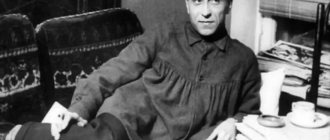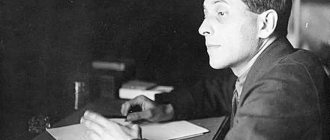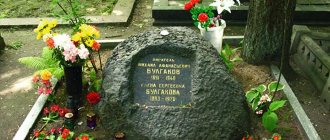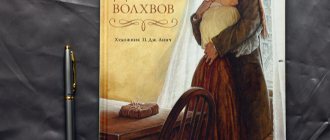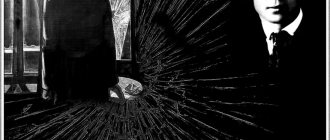Osorgin "Pince-nez" very brief summary
“Pince-nez” Osorgin summary for the reader’s diary:
The first sentence of M. A. Osorgin’s story “Pince-nez” contains the statement that things “live their own lives.” The writer’s “hours are ticking, he’s sick, he’s coughing,” “the stove is hissing,” “the scissors are screaming.” Osorgin actively uses personification, with the help of which inanimate objects acquire animate qualities.
For example, a clock does not go, but walks, just as a cough conveys the chime of a clock. Metaphor is often used, so in Osorgin everyday household things acquire their own special character: “working things”, “democratic glass”. Osorgin sees “something amazing” in jewelry, subtly noticing all the little things, he puts them together, drawing not an object, but a human character.
The history of pince-nez is indicative. The author talks about how things live their own lives, about their intentions and actions. He uses as an example the fact that things are suddenly lost and found just as unexpectedly. This humorous statement is akin to the “law of meanness.”
The author talks about the missing pince-nez, which disappeared while reading. Having searched all the pockets, the chair, the book, the whole room and finally the apartment, I still couldn’t find him. But the story of the search for pince-nez reached the point of general cleaning, but despite the fact that “the whole apartment was updated and brightened,” it was not possible to find the missing pince-nez.
His friend came to the author’s aid and tried to solve this riddle logically by drawing a plan of the room, which he had been thinking about for a long time. However, these thoughts yielded absolutely nothing. The missing pince-nez was found completely unexpectedly, but the fact of its discovery is considered as something completely natural: “you should have seen the face of my pince-nez, returning from a long walk.”
The author treats this subject as an animate being, with its own character, needs, living its own life. Like any living creature, pince-nez dies. His death is described by the author according to all the canons of drama: “this pince-nez ended tragically,” breaking into small fragments.
Features of the story "Pince-nez"
Osorgin’s works contain both a passionate love for nature and close attention to all living things on earth. And in several stories one can even see an unusual attachment to things that are unnoticeable and irreplaceable in everyday life. These works were included in the “Things of Man” cycle.
Osorgin included “Pince-nez” in this collection, a brief summary of which we will consider later. With subtle humor and extraordinary observation, the author talks about ordinary things as if they were animated, had character and destiny. Osorgin also describes pince-nez in this way. The summary, of course, does not give an idea of the author's style. The story is worth reading in full. For those who want to save time, below is a condensed summary of the work that the Russian writer M. A. Osorgin created in the first year of emigration.
A short retelling of “Pince-nez” by Osorgin
Summary of “Pinces-nez” Osorgin:
The work tells about the author’s attitude to the ordinary things around us. The writer claims that every household thing has its own life, its own character. Some are great workers (thermometers, candles), while others are free wasters of time (jewelry).
Some things tend to move in space (matches, pencils). Any person has more than once found himself in a situation where he could not find a missing thing, and after a while it suddenly turned up.
The narrator tells about an incident that happened to him related to his favorite thing - an unsightly old pince-nez.
One evening, while reading an entertaining book, the author decided to clean the glasses of his pince-nez, but as soon as he tried to carry out his plan, he discovered that the usual thing was missing. The man immediately rushed to search for the loss. He looked around: the book pages, the chair, the table, but the pince-nez was nowhere to be found.
Surprised by the unexpected event, the writer did not stop the search, but only expanded its territory. He went into the hallway, then into the shower room, and looked at all the clothes. The author suddenly remembered the sound he heard when his glasses fell. He began his search again, crawling through all corners of the apartment, but again failure awaited him.
The next day, a maid came to the writer’s aid and gave the house a thorough cleaning. She cleaned the entire apartment, including the landing, but was unable to find the missing pince-nez.
After some time, a friend of the writer, having heard about the loss of his friend’s favorite thing, suggested that he solve this problem using logic. On a piece of paper, he depicted a room with furniture placed in it, interviewed everyone who had access to the room, and asked whether there were pets in the house.
Then the researcher conducted a detailed interview with the owner of the apartment, asking him about his every step minute by minute. Having started the thought process, the author’s friend still did not find the answer to the disappearance of the owner’s beloved pince-nez, but for a long time he was under the impression of what had happened, anxiously spending his sleep time.
Several weeks have passed. The writer again engaged in his favorite pastime and enjoyed reading with enthusiasm. Now he was helped in this by new glasses, which were extremely unusual and uncomfortable for the author. The narrator was making pencil marks in the margins of the book, and at one point the pencil slipped through the man’s fingers and rolled into the corner of the room.
Rising from his chair to pick up a fallen pencil, the writer suddenly thought that he had unexpectedly lost his sight. Next to the pencil, he was delighted to discover the missing item lying quietly. The glasses of the pince-nez gleamed faintly and it seemed as if the face of the glasses had a guilty expression.
The writer's surprise knew no bounds. He grabbed his faithful friend and was ready to personally ask the pince-nez about his travels during his long absence. The author proudly and with great pleasure showed both the servants and friends the expensive item that had returned to him. True, the friend, who tried to find the pince-nez in a logical way, did not admit his mistake and claimed that he was looking for the thing in the wrong dimension where it was then located.
The life of glasses stopped one day in the most banal way. The writer picked up an old dusty book and suddenly sneezed, the pince-nez flew off the man’s nose and, falling to the floor, shattered into small particles.
The writer was very sad about the loss of his beloved comrade, with whom he spent many pleasant moments in his life.
This is interesting: The story “The Mask” was written in 1884. On our website you can read a summary of the story “The Mask” by A. P. Chekhov for the reader’s diary.
The plot of "Pince-nez" with quotes
M. Osorgin “Pince-nez” summary with quotes from the work:
According to the narrator, “things live their own special lives” - they feel, think, talk and mimic their owners. Each of them has its own character.
There are hard-working things: a democrat glass, a reactionary stearin candle, an intellectual thermometer, a handkerchief - “a loser from the bourgeoisie”, a postage stamp - “an eternally young and fussy gossip.” They despise a hat with a drunken actor's face, a coat with a pitiful soul and slight drunkenness, ladies' jewelry in which something parasitic is felt.
“Only a completely insensitive person can deny that the teapot, this good-natured comedian, is a living being”...
Some small things, such as a matchbox, pencil or comb, like to travel. After studying their lives for years, the narrator came to the conclusion that sometimes they “go for a walk,” and the duration of the trip can be any,
The wanderings of some things have gone down in history - the disappearance of a blue diamond or the work of Titus Livy, but in them “human will is partly involved.” Small things walk completely independently. How many times, while reading in bed, did the narrator lose a pencil, search for it for a long time in the folds of the blanket and under the bed, and then find it between the pages of the book, although he definitely remembered that he had not put it there.
People explain the loss of small things by their own absent-mindedness, theft, or do not attach any importance to it, but the narrator is sure that things live in their own world, parallel to the one that people invented for them. The narrator recalls an “amazing incident” that happened one day with his pince-nez.
While reading in his favorite chair, the narrator took his pince-nez off his nose to wipe the glass, and... it disappeared. The pince-nez was not in the crevices of the chair, nor under it, nor in the folds of clothing, nor between the sheets of the book, nor on the narrator’s nose.
Amazed by the monstrously absurd situation, the narrator undressed and carefully searched his clothes, then swept the floor, searched the next room, looked at the hanger and into the bathtub - the pince-nez was nowhere to be found. Remembering that he heard the sound of a fall, the narrator crawled around the room for a long time, but did not find a single crack in the parquet floor where the damned pince-nez could fall through.
About a week has passed. The servants washed the apartment and the back staircase, but did not find the pince-nez. The narrator told his friends about this incident. They laughed skeptically and tried to find the pince-nez themselves, but were not at all successful.
One of the friends, who had previously been a calm person, tried to use the inductive method, asked the narrator a bunch of strange questions, thought for a long time, but did not come to any conclusion, left the narrator in a gloomy mood and, according to his wife, moaned in his sleep all night.
One day the narrator was sitting in the same chair and reading in a brand new, irritatingly tight pince-nez. His pencil fell. Fearing that this thing would also go on a journey, the narrator dived under the chair after him. The pencil lay against the wall, and next to it, pressed upright against the wall, the pince-nez glittered. His face with dusty glass was pitiful and guilty.
“How to explain such a strange attachment of things to a person, forcing them to return, even if they managed to so cleverly deceive his vigilance” ...
It is not known where the pince-nez wandered, but from its appearance it was clear that it walked “for a long time, until exhaustion, satiety and terrible mental fatigue.”
The narrator severely punished the reveler: he left him against the wall for several hours and showed him to the servants and all his friends, who only said that the pince-nez “fell strangely.” That same evening, while removing a dusty folder of manuscripts from the top shelf of the closet, the narrator sneezed, his pince-nez fell to the floor and broke.
The narrator chose to consider this an accident rather than a suicide, to which the unfortunate song was led to by the “public shame” he arranged. The narrator feels sorry for the pince-nez; with it he read “many good and stupid books” in which people have passions, reason and consciousness, and things do not have the right to independence.
Presentation for the lesson
Back forward
Attention! Slide previews are for informational purposes only and may not represent all the features of the presentation. If you are interested in this work, please download the full version.
Lesson objectives.
To arouse students’ interest in the work of M.A. Osorgina.
- To reveal to students the peculiarity of the writer’s perception of the world of things.
Equipment: interactive whiteboard.
During the classes
I. Teacher's opening speech.
Often we all lack communication, trust, and understanding.
We find ourselves in an atmosphere of relaxed, unartificial conversation thanks to the work of M.A. Osorgina. The author does not invent, does not embellish, but “simply” tells what happened, without literary pretensions.
Much in his stories may seem “naive and sensitive” (in his own words), but the reader is created with a complete illusion of simplicity and truth.
“Love of life” is the author’s only philosophy.
II. Reading an article from O. Avdeeva’s textbook about M.A. Osorgine.
Mikhail Andreevich Ilyin (Osorgin is the writer’s pseudonym) was born in Perm. His memories of childhood were bright, he called on them in the most difficult moments - they helped him live. The kindness of loved ones and the pictures of nature that completely filled the world in his childhood years remained with him forever. The boy fell in love with books early. He was a 7th grade high school student when the magazine “For Everyone” published his story “Father.”
The writer is a big worker. The work for his soul was the implementation of the plan of his first novel “Sivtsev Vrazhek” - about the tragedy of the Russian intelligentsia in difficult, troubled times.
All of Osorgin’s work was permeated by two sincere thoughts: a passionate love for nature and attachment to the world of ordinary, imperceptible things. The second idea formed the basis of the story “Pince-nez”.
He took part in revolutionary activities and was expelled from the country.
III. Work with text.
Mikhail Osorgin's story evokes surprise from the very first question of the author. What is the question?
This is a rhetorical question: “That things live their own special life - who can doubt it?”
What should no one doubt?
Parallel to the life of a person, there is the life of things - active and “animate”.
What does the narrator want to convince us of?
Everyday objects have their own “face”, their own “character”, moreover, they are endowed with “mind”.
IV. Be careful with the word.
Working with slides
“Unusual” life
" of things".
Things have human qualities, they are endowed with a sense of humor: “a hanging coat always has a pitiful soul and slight drunkenness”
.
…some things have “wanderlust.” Moreover, things have their own social status and political beliefs: “a democratic glass, a reactionary stearin candle, an intellectual thermometer, a loser from the philistine - a handkerchief, an eternally young and fussy gossip - a postage stamp.”
The qualities inherent in objects arise from the similarity of sounds, shapes, and content. Give examples of metaphors
from the text.
For example, “spread scissors scream” because they resemble a mouth open in a scream; “the clock is walking” is the implementation of the metaphor “the clock is walking”, “the chair is sitting”, because its outline resembles a sitting person, etc.
Conclusion. The entire story is permeated with a sense of humor and filled with the author’s unbridled imagination.
It seems to the reader that the objects Osorgin is talking about exist on their own, regardless of the writer, he enters this long-vanished wonderful world, recognizes the familiar and the forgotten, lives in it without looking back at the author. And he stands aside in the modest role of a guide.
What artistic techniques are used to achieve this effect?
Numerous long rows of homogeneous members, appeals to the reader; grammatical - the use of second-person verbs in the present tense (“rummage, search, get angry, ... look, get up, climb, look in”, etc., which achieves the effect of the reader’s presence in the action; intonation (many exclamation marks, interrogative sentences), the use of colloquial words, imitation of colloquial speech: the “face” of the hat is “a drunken actor”, “little soul”, “ignorant”, “wandering around”, “No-one!”, “And suddenly - once! - and the pencil falls” .
VI. Retelling fragments of text.
What is the history of the pencil? What journeys does he make when people are looking for him?
What happened to the pince-nez? What story happened to him?
Give examples of epithets that serve to animate pince-nez.
There are many expressive epithets in the story: “crystal soul” pince-nez, “pathetic guilty” pince-nez, which “revealed a picture of such slavish humility, such cowardice...”, “spun glass.”
Would it be possible to think that the disappearance of the pince-nez was a manifestation of his individuality?
Things have the right to express their will, to express their individuality.
VII. Develop the gift of words.
/Presentation of works “History of Objects”./
Each of us has things that can disappear without a trace for a while, but then unexpectedly return. In such cases, I wonder: don’t such things have a life of their own? Everything is possible.
I’ll tell you about one of my little things that I pick up a hundred times a day - a mobile phone case. It should be on or near the phone.
When I go to bed, the phone, as usual, lies on the table by the bed, but the case can lie all night in an unknown place. I can look for him all evening without any success, and in the morning, getting ready for school, I can find him without any problems.
But very often, especially in the summer, I leave it somewhere and forget.
One day it happened that I was talking on the phone in the garden, and I put the case in my pocket and lost it. I looked for him for a long time, but did not find him. A week later, leaving the house, I saw him lying on the porch. It turns out that my dog brought it. I don’t even know where he found it.
Another amazing story happened to my sister. In the fall she bought herself gloves. But soon she lost her left glove. She put the second one at home. A lot of time passed, my sister bought the same pair of gloves.
One winter, returning home from school, she saw a glove hanging on a tree branch. It was her! That lost glove! Where was she all this time and how did she return to her owner?
The story of an old textbook
I am an old and wise Textbook and have seen a lot in my time. Throughout my life I have met many guys. Communication with them left me with either warm memories or unpleasant marks.
For example, when I lived with Nadya, I always felt comfortable and good, because she rarely took me out of the shelf, and even more rarely opened it. My pages then were clean, white, and the cover was bright and colorful.
Artyom communicated with me much more often than Nadya. He carried me to school in a big beautiful backpack, where my book friends lay nearby. To prevent us from rubbing against each other and to prevent our roots from being torn off, the boy dressed us in bright, elegant covers from the very beginning of the school year. We felt fashionable and beautiful.
And then a dark streak came in my life. I fell into the hands of the book villain Andrei. What have I not experienced! It was terrible! Andrei tried to redraw my inserts with reproductions of famous paintings in his own way, grabbed me with dirty, sticky hands, and sometimes even tore out sheets of paper from me and made airplanes. I was especially shocked by Andrei’s attempt to convince his friend of something: he hit him on the head with me! From such a strong blow I almost crumbled into all the leaves!
Now I’m standing in the library: I’ve become old, they won’t let anyone take me, I can only use it in the reading room. And rightly so, I feel calmer this way.
We are surrounded by a large number of different objects. Often in everyday life we do not pay much attention to them. But sometimes I began to notice that the things around me had their own lives, independent of people. They disappear and reappear whenever they please. This happens to me very often.
I have a disc on which I recorded my favorite songs. And one day I wanted to listen to him. I was surprised when I didn’t find it in its usual place. It usually sits on a shelf next to the computer along with other drives. But this time he wasn't there. Maybe I just didn’t see it among all the other discs. I looked more closely, but didn't find him. It wasn't in my room either. I started to panic. Where could I put it? I searched the whole house for the disk, but it was still nowhere to be found. After unsuccessful searches, I got busy with more important things, and for some time I even forgot about the disk.
One day, on a day off, I was cleaning the house, and by chance my gaze fell on the shelf where the disk usually lay. He, as if nothing had happened, lay in the very place where he was supposed to lie. I was glad that he had finally been found, but it became unclear to me why I had not seen him earlier. I started thinking, what if all things live “their own” life? And we people simply don’t notice this. We think that we moved things somewhere else or gave them to someone else to use and simply forgot about it. But, nevertheless, things continue to exist separately from us. They get lost and find themselves again whenever they want.
Lesson summary.
How does the story combine the real and the fantastic? Give examples.
All objects described by Osorgin are real. It is also true that some objects often disappear and are suddenly found in the most amazing places. It’s fantastic that objects live a completely independent life, have soul, character, mood, and a thirst for travel. The author's imagination endows things with human qualities.
"Pince-nez"
Only a completely insensitive person can deny that the teapot, this good-natured comedian, is a living being; namely the teapot, since the coffee pot, for example, lives a life less individual and noticeable.
But I have always been especially fascinated by one curious feature in the life of things - not all, but some. This is wanderlust. These are: a box of matches, a pencil, a cigarette holder, a comb, a neck cufflink, and a few more. Having carefully and lovingly studied their lives for many years, I first assumed, and later became convinced, that these things go out for a walk from time to time - for a minute, for an hour, sometimes for a very long time. There are historical cases (the seven-branched candlestick, the blue diamond, the historical work of Titus Livius, etc.), but human will, chance, and malicious intent are partly involved in such disappearances; Using the example of small things, it is easier to establish complete independence of actions.
Usually we explain such disappearances either by our absent-mindedness, or by someone else’s carelessness, and often by theft. I used to think so myself, and if it had not occurred to me to observe the life of things without a preconceived idea of their passivity and “inanimateness,” I would still think so elementary.
Everyone who reads in bed knows with what persistence a pencil, a cutting knife, or a box of matches gets “lost” in the folds of the blanket. With a familiar gesture, you place a pencil on the blanket. A minute later - no pencil. You fumble, search, get angry: no and no. You pull back the sheets, look under the pillow, on the rug, on the table: it’s nowhere. You get up grumbling, climb into your shoes, look under the bed, find matches, a cufflink, an open letter - but there is no pencil. Shivering from the cold, you trudge to the table, take another pencil (usually it turns out to be unrepaired), fix it, and return. Having tucked a blanket under you to keep warm, you finally pick up the book, put aside because there was nothing to mark the right place with. You open the book - there is a pencil in it.
The first sentence of M. A. Osorgin’s story “Pince-nez” contains the statement that things “live their own lives.” The writer “walks for hours, gets sick, coughs.” “The stove hisses.” "The scissors are screaming." Osorgin actively uses personification, with the help of which inanimate objects acquire animate qualities.
For example, a clock does not go, but walks, just as a cough conveys the chime of a clock. Metaphor is often used, so in Osorgin everyday household things acquire their own special character: “cloth workers.” "democratic glass"
Osorgin sees “something amazing” in jewelry, subtly noticing all the little things, he puts them together, no longer drawing an object, but a human character.
The history of pince-nez is indicative. The author talks about how things live their own lives, about their intentions and actions. He uses as an example the fact that things are suddenly lost and found just as unexpectedly. This humorous statement is akin to the “law of meanness.” The author talks about the missing pince-nez, which disappeared while reading. Having searched all the pockets, the chair, the book, the whole room and finally the apartment, I still couldn’t find him. But the history of the search for pince-nez has reached the point of general cleaning,
But despite the fact that “the whole apartment has been updated and brightened.” The missing pince-nez was never found.
His friend came to the author’s aid and tried to solve this riddle logically by drawing a plan of the room, which he had been thinking about for a long time. However, these thoughts yielded absolutely nothing. The missing pince-nez was found completely unexpectedly, but the fact of its discovery is considered as something completely natural: “you should have seen the face of my pince-nez, returning from a long walk.”
The author treats this subject as an animate being, with its own character, needs, living its own life. Like any living creature, pince-nez dies. His death is described by the author according to all the canons of drama: “this pince-nez ended tragically.” breaking into small fragments.
Essays on topics:
- The story “The Gifts of the Magi” was written back in 1906. A little more than a hundred years have passed since then. During this time…
- The story begins like this: “I was brought to the hospital with typhoid fever.” The hero came across “some special hospital” where he didn’t like it at all...
- K. Paustovsky - story “Meshcherskaya Side”. Nature for K. Paustovsky is not only beautiful pictures of fields, hills, rivers and...
- The main character of the story - a weirdo, with whom something constantly happens - is going to the Urals, to his brother, who has not been alive for twelve years...
October 24, 2016
Do you remember the first lines of “Moidodyr” by Korney Chukovsky, how a bow-legged and lame washbasin ran out of my mother’s bedroom? As children, we took it quite seriously and did not ask unnecessary questions either to ourselves or to adults. Yes, everything around us is alive: the washbasin, the cups, and the kettle... But with age, this bright, clean, unclouded world begins to gradually dim, fade, turning into a banal fiction. However, not all. There are rare exceptions. One of them is the writer Mikhail Osorgin. “Pince-nez” is a story about the amazing world of “revived” things in the life of an adult.
